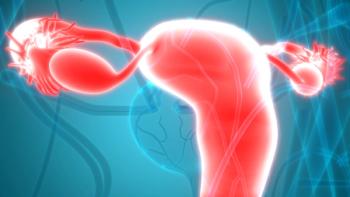
Oncology NEWS International
- Oncology NEWS International Vol 9 No 5
- Volume 9
- Issue 5
Transvaginal Ultrasound Screening for Ovarian Cancer
SAN DIEGO-Annual transvaginal ultrasound screening permitted early detection of most ovarian cancers and improved 5-year survival from about 50% to 88% in screened patients, John R. van Nagell, MD, reported at a plenary session of the 31st Annual Meeting of the Society of Gynecologic Oncologists (SGO).
SAN DIEGOAnnual transvaginal ultrasound screening permitted early detection of most ovarian cancers and improved 5-year survival from about 50% to 88% in screened patients, John R. van Nagell, MD, reported at a plenary session of the 31st Annual Meeting of the Society of Gynecologic Oncologists (SGO).
The goal of this study was to determine the efficacy of annual transvaginal ultrasound screening as a test for ovarian cancer, Dr. van Nagell told ONI in an interview. Efficacy was defined as the ability to decrease the stage of cancer at detection and to affect case-specific survival. Dr. van Nagell is in the Department of Obstetrics and Gynecology, University of Kentucky, Lexington.
The investigators performed annual transvaginal ultrasound on 14,469 asymptomatic women from 1987 to 1999. The study included women who were either age 30 or older with a family history of ovarian cancer, or age 50 or older. An abnormal sonogram was defined as showing either an ovarian volume greater than 10 cm³ in postmenopausal women or greater than 20 cm3 in premenopausal women, or a papillary or complex tissue projection into a cystic ovarian tumor.
The transvaginal ultrasound procedure requires about 5 minutes to perform. It is provided at no cost to study patients, but Dr. van Nagell estimated that it might cost $35 in routine use.
Exactly who should be screened is unclear, but Dr. van Nagell said that two high-risk groups are candidates: all women over age 50 and women over age 25 who have a documented family history of ovarian cancer in a first-degree or second-degree relative.
Sonograms were repeated at 4 to 6 weeks in women who had abnormal screening sonograms. The investigators did serum CA 125 assays, tumor morphology indexing, and Doppler flow sonography of women with persistently abnormal scans, and those women were advised to have surgical tumor removal.
As a result, 180 patients with persisting transvaginal ultrasound abnormalities underwent exploratory surgery, which revealed 17 ovarian cancers. Eleven were stage I, three were stage II, and three were stage III. At the time of the presentation, all patients with stage I or II ovarian cancer were still alive without recurrence at a mean follow-up time of 4.6 years (range, 0.82 to 9.6 years). Two of the three stage III patients have died of disease.
Four patients developed ovarian or primary peritoneal cancers within 12 months after a negative scan. Two of these were stage II, and two were stage III. Dr. van Nagell said that three of these patients were alive with no evidence of disease at 0.2 years, 1.7 years, and 5.5 years after diagnosis, and one patient died of disease 0.7 years after diagnosis.
In this group of screened women, transvaginal ultrasound had a sensitivity of 81% and specificity of 98.9%. Positive predictive value was 9.4%. Negative predictive value was 99.97%.
After 46,113 screening years, there have been three ovarian cancer deaths in this annually screened population. The survival of ovarian cancer patients in the study population was 95% at 2 years and 88.2% at 5 years, he said.
The investigators concluded that annual transvaginal ultrasound screening is associated with a decrease in stage at detection and a decrease in case-specific ovarian cancer mortality, but does not appear to be effective in detecting primary peritoneal cancer.
If annual transvaginal ultrasound screening is done in a center with experienced people to read the sonograms, I would expect a significant decrease in mortality from ovarian cancer in the screened women, Dr. van Nagell said. The implication of our study is not that we should start doing transvaginal ultrasound in every office. We have about 50,000 screening-years of data, and we need at least 100,000 screening-years before it is ready for widespread use.
Transvaginal ultrasound screening is currently available at the University of Kentucky and at National Cancer Institute sites associated with the PLCO (Prostate, Lung, Colon, Ovarian) screening trial, Dr. van Nagell said.
Articles in this issue
over 25 years ago
HRT Not Associated with Lower Survival After Breast Cancerover 25 years ago
Age No Contraindication to High-Dose Therapy in Myelomaover 25 years ago
ASCO Urges Passage of Patient’s Bill of Rightsover 25 years ago
RT Not Necessarily an Impedance to Breast Reconstructionover 25 years ago
New Adjunctive Regimens for Breast Cancer Treatment Are Under Studyover 25 years ago
NCCN Prostate Cancer Practice Guidelines Revisedover 25 years ago
ERT Does Not Increase Endometrial Cancer Recurrenceover 25 years ago
Radiochemotherapy/Transplant in Low-Grade Lymphomasover 25 years ago
Fish Oil Supplements May Improve Cancer Therapies’ Effectivenessover 25 years ago
Study of Dying Cancer Patients Reveals Importance of RitualsNewsletter
Stay up to date on recent advances in the multidisciplinary approach to cancer.
































































































